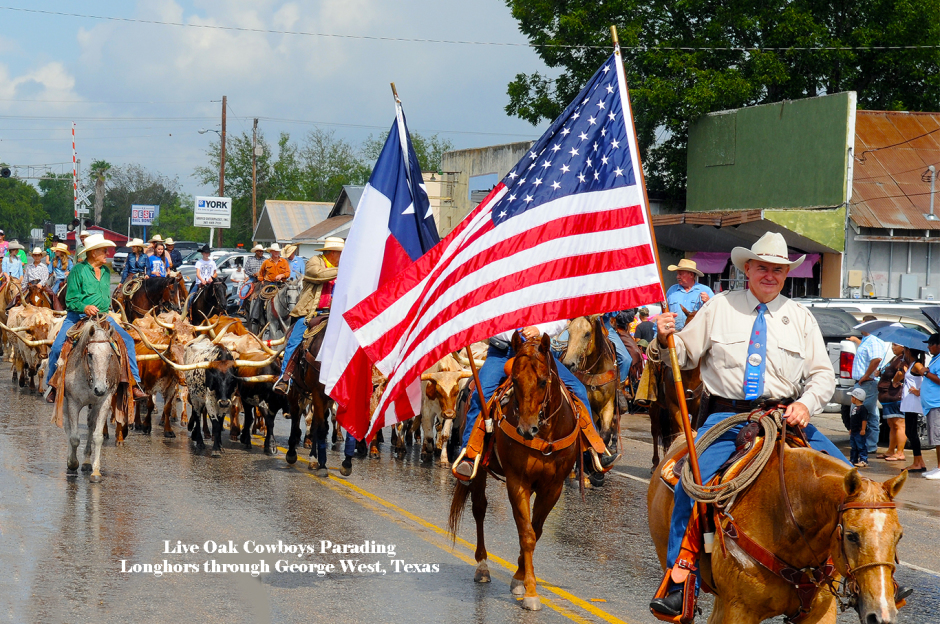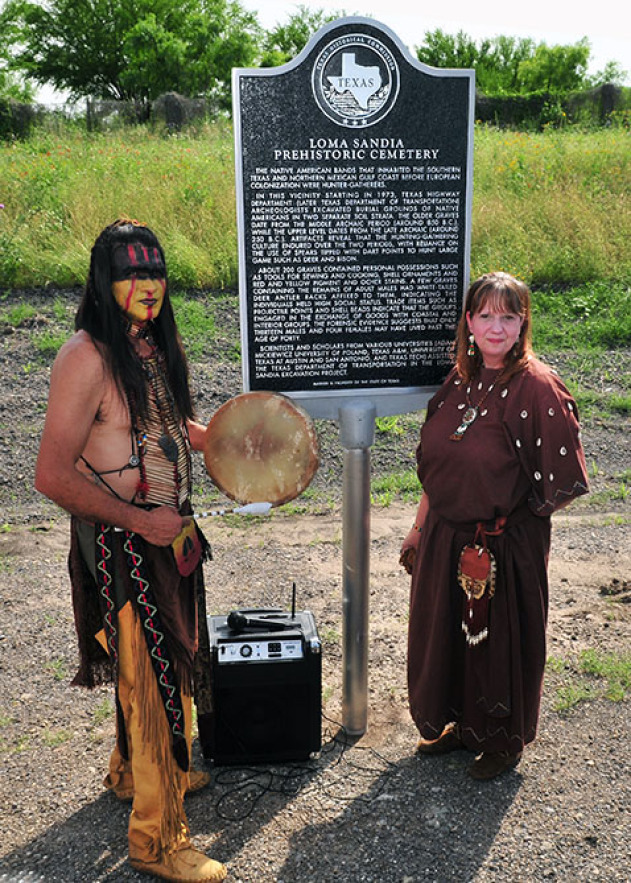
Loma Sandia, Prehistoric Cemetery-Texas Historically Undertold Story
Balde Mara Galvan, Jr. and Lillian Burmeister Casper, representatives from the Native American Council of Beeville opened the Loma Sandia Marker Unveiling with a blessing ritual for those buried at Loma Sandia and ended with a Native American pipe ceremony in honor of the ancestors. Photo courtesy Brett Walker.
Live Oak County Judge: Honorable Jim Huff
Live Oak County Historical Commission Chair: Sue Denniston/Leslie Walker. (Denniston was chair at the time of Loma Sandia application in 2012. THC accepted it as a Historically Undertold Story which meant that the marker was then paid for by the THC.and completed after Walker became chair in 2015. As a prehistoric cemetery, Loma Sandia is not a Texas Historic Cemetery because it is a cemetery which pre-dates the Historic Period.)
LOCHC Marker Chair: Richard Hudson
Assistant Chair: Janis Hudson
Loma Sandia Undertold Story Sponsors: THC and LOCHC
Date Approved: 2012 Unveiled: 2015
Contact: rehudson@liveoakchc.com
Loma Sandia Undertold Story Text:
Loma Sandia Prehistoric Cemetery
"Coahuiltecan" is a generic name for Native American tribes that inhabited the southern Texas and northern Mexican Gulf Coast before European colonization. These hunter-gatherer groups either died out or were renamed in the early historic era. In this vicinity, archeologists excavated burial grounds of Coahuiltecan groups in two separate soil strata. The older graves date from the middle-archaic period (around 850 B.C.), while the upper level dates from the late-archaic (around 250 B.C.). Artifacts reveal that the hunting-gathering culture remained largely unchanged over the two periods, although bows and arrows used in the late-archaic period provided improved access to protein from large animals such as buffalo.
About 200 graves contained personal possessions such as tools for sewing and cooking, shells for jewelry and red ochre for cosmetics found with female remains. A few graves containing the ashes of adult males had white-tail deer antler racks affixed to them, indicating the individual had a high social status. Trade items such as arrowheads and beads indicate that the groups engaged in trade with coastal and interior tribes. The forensic evidence suggests that only thirteen males and four females may have lived past the age of forty.
Scientists and scholars from one foreign (Adam Mickiewicz University, Poland) and four Texas (Texas A&M, University of Texas-Austin and San Antonio, and Texas Tech) Universities and the Texas Department of Transportation cooperated in the Loma Sandia excavation project, the largest archeological-historical venture of its era. (2012) Marker is the property of the State of Texas.
APPLICATION NARRATIVE and BIBLIOGRAPHY FOR TEXAS OFFICIAL UNDERTOLD STORY HISTORICAL MARKER:
Loma Sandia, Prehistoric Cemetery (41LK28)
I. Context
Loma Sandia (41LK28), a prehistoric cemetery and campsite three miles north of Three Rivers, Texas located in proximity to Interstate Highway 37 and also near Oakville, Texas became the state’s largest area and combined archaeological-history venture before its time in 1977. Investigations at the site lasted from September 1977 until October 1978.[1] Excavation and study at Loma Sandia (Watermelon Hill) involved the efforts of the Texas Highway Department, later the Texas Department of Highways and Public Transportation (now TxDOT), Texas Tech University, Texas A&M University College Station, University of Texas Austin, and University of Texas San Antonio.[2] The excavation worked within standards set by the Memorandum of Understanding between the Highway Department and Texas Antiquities Committee, dated January 5, 1972.[3]
II. Overview
In 1973, “surface artifacts” were discovered in a preliminary review of proposed property for the new Interstate Highway 37 right of way. Finally in 1977, the Loma Sandia project brought together eight archaeologists and 18 local workers of combined fields in archaeology, anthropology, and history.[4] In all, a total of eleven professional archeologists, two physical anthropologists, with approximately 52 local crew members did the work.[5] The site, situated beside Hackberry Creek, a small tributary of the Frio River just above the point where the Atascosa connects with the Frio and Nueces Rivers, is a large cemetery with burials of about 205 aboriginal individuals who belonged to the Coahuiltecan culture. Closely interred remains were found at two separate levels with the mortuary spanning a short period of time during the late Middle Archaic period from 850 to 250 B.C.[6] This cemetery then predates Cabeza de Vaca’s journal, La Relación, the first recorded history of this area,[7] and European exploration accounts by later Spanish explorers;[8] therefore, it gives a closer look at earlier prehistoric times in South Texas.
The Loma Sandia site, “truly led to significant advances in our understanding of the ancient peoples of the region,” says Dr. Thomas R. Hester, director of the Center for Archaeological Research, and Associate Professor of Anthropology at the University of Texas in San Antonio during the time of the excavation and later associated with the University of Texas Austin. According to Dr. Hester, prior to Loma Sandia, only single grave findings existed in South Texas. These suggested a merely nomadic culture with little or no societal or territorial boundaries. However, Loma Sandia cemetery documents a more communal culture where groups of people with a common language returned at least intermittently over a period of several hundred years and repeated the same ritual services. Secondly, artifacts found with the buried show slowly developing tool sophistication over time. Beyond these, other artifacts point to trading patterns between both coastal tribes and those from farther west.[9] Dr. Maciej Henneberg, Professor in Archaeological Studies from Adam Mickiewicz University in Pozan, Poland, and visiting lecturer with the University of Texas, Austin also working at the site, determines population and cultural aspects from individuals and their artifacts.[10] As late as early 2012, Dr. Henneberg, now located at the University of Australia in Sydney remarked that the definitive cultural findings of Loma Sandia are still to be written.[11]
Various tribes consisting of about 200 bands bound by similar Coahuiltecan language dialect ranged from San Antonio southward into Mexican Coahuila and Tamaulipas and may have come from as far west as California.[12] Loma Sandia’s burial grounds represent one particular group of these nomadic food gatherers and hunters. Artifacts buried with the deceased aborigines support a similar culture[13] as the one reported by Cabeza de Vaca of family groups gathering to eat and celebrate ripening “tuna” (fruit of prickly pear cactus) in late summer and then gathering pecans during winter months. Tubers, small creatures, earth substances, and occasional larger animals completed a meager diet inclusive of intermittent periods of environmentally imposed fasts.[14]
The earliest artifacts found at Loma Sandia often mistakenly referred to as “arrowheads” are actually hunting tools consisting of sharp pointed flint projectiles lodged on short spears and discharged from a spear-thrower to snare both living creatures and fish. In contrast, the Aztecs used these spear-throwers called “atlatl” for military means. Chipped flint points and their tools abound throughout the area and are found in many private collections.[15]
III. Significance
The Later Archaic excavation nearer the surface of Loma Sandia reveals a somewhat changing life style bringing better health to local inhabitants. Bison bones demonstrate their movement southward as the northern buffalo population explosion pushed them in search of ample vegetation. With the buffalo came other hunting tribes such as the Lipan Apache and Comanches. They brought the bow and arrow, better for capturing bison, but spawning contention among the tribes as well. Additional finds such as shells from the seashore and beads from the west evidence increased trade with other roaming tribes from the coast and Midwest.
Personal belongings reveal further lifestyle information. Pouches for women with tools for sewing and cooking, shells for jewelry, and red ochre for cosmetics depict domestic customs. Several graves contain cremated ashes of adult men. White-tail deer antler racks affixed to their graves indicate possible chieftain or other status. Only thirteen males and four females uncovered at the site are believed to have lived past the age of 40.
As more refined south Texas chronologies develop, even greater understanding is developing.
IV. Documentation
[1] Taylor, Anna and Cheryl Highley. Archeological Investigations at the Loma Sandia Site (41LK28) A Prehistoric Cemetery and Campsite in Live Oak County, Texas: Studies in Archeology 20, principal investigators Frank Weir and Thomas Hester. Austin: Texas Archeological Research Laboratory, The University of Texas at Austin, 1995. iii.
[2] Thomas R. Hester, “Archaeological Teams Are Digging in Choke Canyon Dam Area,” Three Rivers Progress, September 21, 1977.
[3] Taylor, A. Ibid. 1.
[4] Hoyt Hager, “Ancient residents ‘studies’ near Oakville,” Corpus Christi Caller, March 6, 1978.
Note from Hager’s article: “Archeological designation 41 signifies Texas, LK-Live Oak County, and 28-the specific site and sequence of Texas digs (41LK28).”
[5] Taylor, A. 9.
[6] University of Texas at Austin-College of Liberal Arts. Texas Beyond History: Loma Sandia http://www.texasbeyondhistory.net/st-plains/images/ap8.html (accessed 1/4/ 2012-10/1/2012.
Author Note: Source of information regarding Loma Sandia use timeline terms B.C. (Before Christ).
[7] Bandelier, Fanny, translation. The Journey of Álvar Núñez Cabeza de Vaca and His Companions from Florida to the Pacific, 1528-1536. Ed. and introduction by Adolph F. Bandelier. Trail Makers’ Series. New York: A.S. Barnes, [(c)1904] 1905.
[8] Foster, William. Historic Native Peoples of Texas. Austin: University of Texas Press, 2008. 107-135.
[9] Hester, Thomas. Forward Archeological Investigations at the Loma Sandia Site (41LK28) A Prehistoric Cemetery and Campsite in Live Oak County, Texas: Studies in Archeology 20, principal investigators Frank Weir and Thomas Hester . Austin: Texas Archeological Research Laboratory, University of Texas at Austin, 1995. xvii-xviii.
[10] No byline. “Burial Pits Near Three Rivers Hold Interest,” Corpus Christi Caller, June 21, 1978.
[11] Telephone interview with Dr. Henneberg at the University of Australia by Janis Hudson, Keller, Texas.
[12] Newcomb, W.W. The Indians of Texas: From Prehistoric to Modern Times. Austin: University of Texas Press, 1993. 29-57.
[13] Taylor, A. Ibid. 59-402.
[14] Adorno, Rolena and Patrick Pautz. Álvar Núñez Cabeza de Vaca His Account, His Life, and the Expedition of Pánfilo de Narváez. Lincoln & London: University of Nebraska Press, 1999. 2:237-256.
[15] Taylor, A. Ibid.

